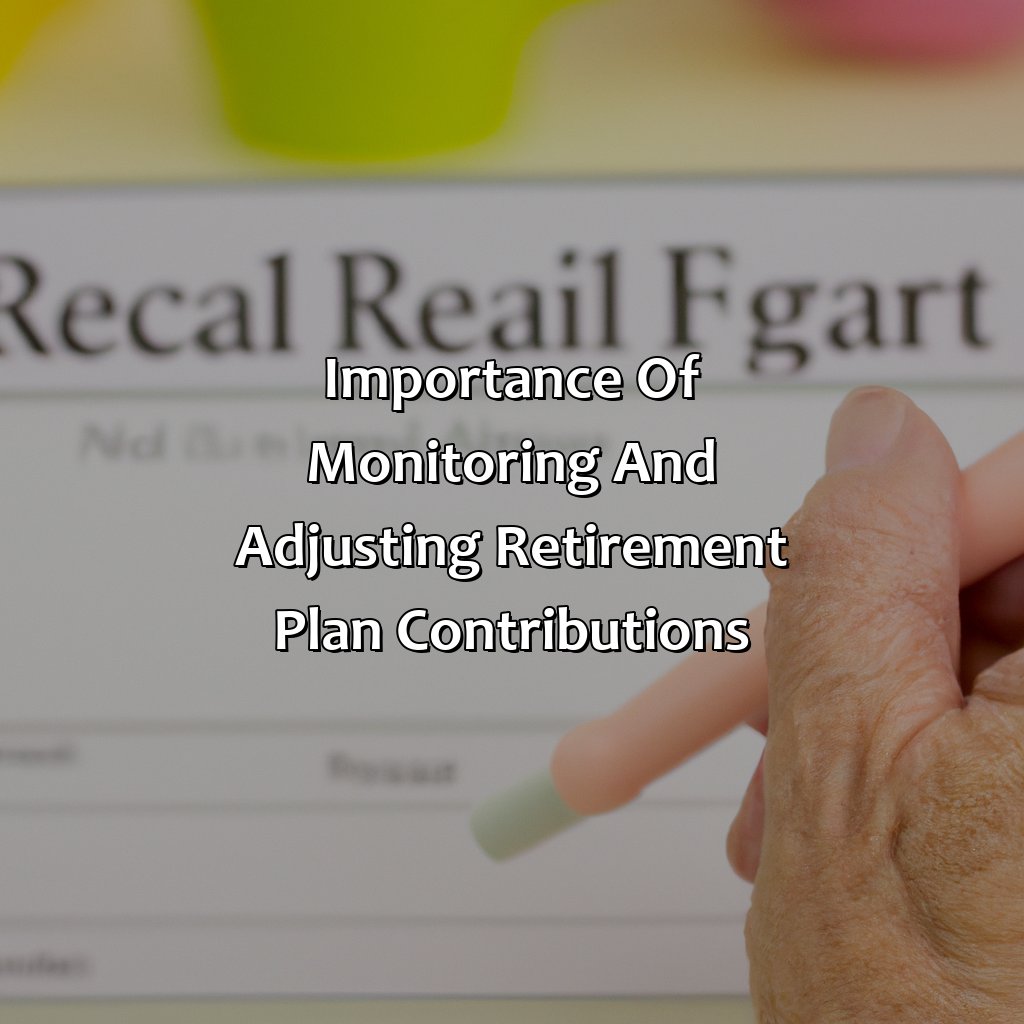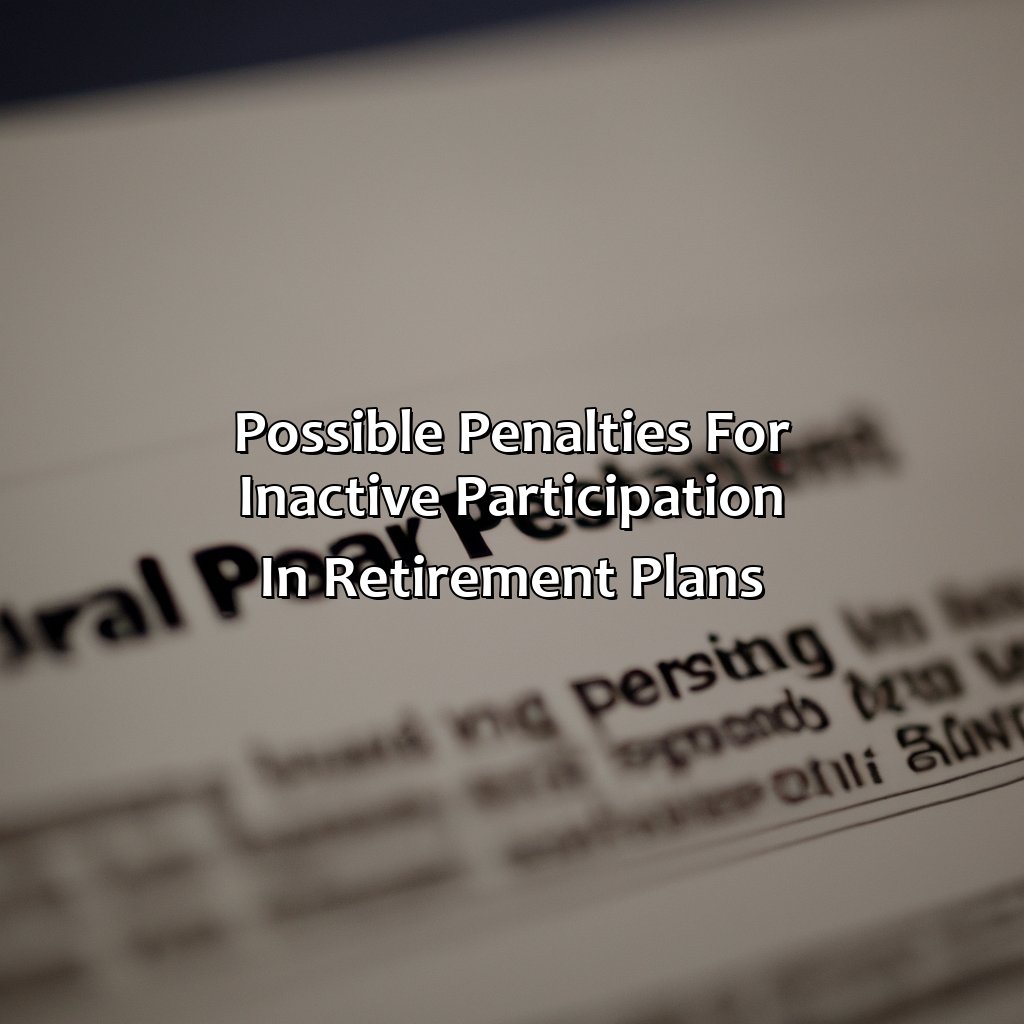What Is An Active Participant In A Retirement Plan?
Key Takeaway:
- An active participant in a retirement plan is an individual who participates in an employer-sponsored retirement plan, such as a 401(k) or pension plan, through contributions or eligibility.
- To qualify as an active participant, an employee must meet certain eligibility requirements, such as completing a waiting period or working a certain number of hours.
- Benefits of being an active participant include employer contributions, tax-deferred growth on contributions, and the ability to save for retirement on a consistent basis.
Key Takeaway:
- To become an active participant, employees must enroll in their employer’s retirement plan during the enrollment period, which typically occurs when they are hired or during an annual open enrollment period.
- Contribution requirements vary depending on the retirement plan, but employees may need to contribute a certain percentage of their income or a specific dollar amount.
- Vesting schedules determine when employees have ownership of employer contributions made to their retirement account and vary depending on the retirement plan and employer. Employees who leave a company before being fully vested may forfeit some or all of their employer contributions.
Key Takeaway:
- To maximize retirement benefits, active participants should consider investment options, such as allocating funds based on their risk tolerance and asset allocation strategies. Catch-up contributions are also an option for participants over 50 to contribute additional funds to their retirement account.
- Retirement income planning involves creating a retirement budget and determining a sustainable withdrawal rate to help ensure retirement savings last throughout retirement.
- Regularly monitoring and adjusting retirement plan contributions is important to ensure participants stay on track to meet their retirement goals. Participants should also re-evaluate their investment strategy and retirement income plan as their circumstances and goals change.
Do you want to secure your financial future? Participating in a retirement plan is a key step to take on that journey, but what is an active participant? Read on to find out.
What is an active participant in a retirement plan?
Want to know what it takes to become an active participant in a retirement plan? Read this section “What is an active participant in a retirement plan?” Here, we’ll define the qualifications for active participant status. Plus, we’ll explain the benefits that come with it. Get all the info you need to qualify as an active participant and enjoy the perks!

Image credits: retiregenz.com by Adam Duncun
Definition of an active participant
An active participant in a retirement plan is an employee who currently contributes to their retirement account. They may do so through salary deferrals or voluntary contributions. Contributions can also be made by an employer on behalf of the employee. The status of being an active participant is important for determining eligibility for certain plan features and benefits.
It is important for employees to understand their status as an active participant in their retirement plan to make informed decisions about their contributions and investment strategies. Employers should provide regular updates and communications regarding retirement plans, including information on eligibility criteria and changes in plan features.
In addition, employees should regularly review and adjust their contribution amounts based on changing financial circumstances and goals. This can maximize the potential growth of their retirement savings over time.
Overall, becoming an active participant in a retirement plan can provide significant benefits for employees, such as tax advantages and matching contributions from employers. By staying informed and engaged with their retirement plans, individuals can take control of their financial futures in retirement.
Get ready to qualify for active participant status: it’s like getting a gold star for being responsible with your retirement, except there’s no prize and you’re just not broke in your old age.
Qualifications for active participant status
Active Participant Eligibility Criteria
To qualify as an active participant in a retirement plan, individuals must meet specific requirements. These involve their participation in the plan and contributions made towards it.
Qualifications for Active Participant Status:
- Contribution Requirements: To be considered an active participant, employees must make contributions to their retirement plan either through payroll deductions or by direct payments.
- Vesting Requirements: Active participants will also need to meet vesting requirements set by the employer. The vesting schedule determines how long an employee needs to work for the company before they can claim ownership of all the contributions made to the plan.
- Employment Status: An active participant is typically regarded as someone who is currently employed, contributing to their retirement plan, and receiving benefits from it.
In addition to these qualifications, factors such as age and job status may impact whether one can participate actively in a retirement plan.
Suggestions:
- Ensure you have a comprehensive understanding of your employer’s vesting schedule and contribution requirements.
- Maintain your employment status and consider increasing your contribution amounts where possible to maximize your benefits. Contributing more often translates into greater savings at retirement time.
Being an active participant in a retirement plan is like being a scout for your future self, always prepared for whatever financial curveballs life throws your way.
Benefits of being an active participant
An active participant in a retirement plan enjoys several benefits, including increased savings, tax advantages, and investment opportunities.
- An active participant maximizes their savings potential by contributing regularly to their retirement plan. They can also take advantage of employer-matching contributions, which can significantly boost their retirement savings.
- Active participants can enjoy significant tax advantages, such as the ability to defer taxes on contributions and earnings. This translates into more money available to grow over time.
- By being an active participant, individuals have access to a range of investment options tailored to their specific needs and preferences. They can diversify their portfolio and reduce risk while optimizing returns over time.
Taking full advantage of these benefits requires consistent participation and careful planning.
Participation in a retirement plan shouldn’t be taken lightly. Individuals who neglect this opportunity risk losing out on years of tax-advantaged growth and financial security in retirement. Don’t wait until it’s too late to take action; start maximizing your retirement savings today.
Start planning for retirement now, because the only thing worse than being broke in your golden years is being broke and still having to work.
How to become an active participant in a retirement plan
Want to be part of a retirement plan with its own enrollment options, contribution requirements and vesting schedules? First, you need to get proactive! Start by educating yourself on your employer’s retirement plan and the enrollment process. Then, decide on your contribution rate and investment choices. Finally, understand your employer’s vesting schedule. This section will explain how to become an engaged participant in your retirement plan, and secure your financial future.
- Educate yourself on your employer’s retirement plan and the enrollment process
- Decide on your contribution rate and investment choices
- Understand your employer’s vesting schedule

Image credits: retiregenz.com by Adam Arnold
Enrollment options
To join a retirement plan, know your ‘enrollment methods.’ Here are the ways you can enroll in a retirement plan:
- Automatic Enrollment: Your employer will enroll you in the plan automatically within 30-90 days of joining the company.
- Opt-in Enrollment: You must choose to enroll and decide on your contribution amount.
- Opt-out Enrollment: You’re enrolled automatically but can withdraw if desired.
- Rollover Enrollment: Transfer retirement assets from another plan or IRA account to this new plan.
When enrolling, follow specific rules that apply to each enrollment method. For example, you may need to complete the beneficiary designation form or submit additional paperwork for a rollover enrollment. Keep track of important dates for deadlines, contributions, and distributions.
It’s crucial to take advantage of any matching contributions offered by employers. Always read all enrollment materials provided and be aware of fees that may apply.
Pro Tip: Review your retirement account regularly and adjust your contribution rate as needed.
Making contributions to your retirement plan is like watering a plant – the more you put in, the better chance it has to grow.
Contribution requirements
To actively participate in a retirement plan, fulfilling the obligation to make contributions is paramount. Meeting contribution requirements necessitates complying with the amount of cash an individual has to put into a retirement fund over time. A Contribution requirement is a mandated savings commitment each participant must meet as part of their retirement plan.
Meeting these financial obligations must be employed consistently, often through payroll deductions, throughout one’s employment duration. Even if an individual does not plan on staying at their job for long, they could still be obligated to satisfy contribution requirements to receive employer-sponsored matching contributions. Alternatively, individuals might have an option of separating from employment altogether and withdrawing the savings in the appropriate type of cash account.
When it comes to meeting contribution requirements, failure to comply may result in forfeiture of tax benefits and possible penalties levied by the IRS or other regulatory governing bodies. It is essential always to understand any specific documentation outlining specifics related to financially supporting the retirement benefit perfectly.
Accordingly, some experts suggest 401(k) auto-plans, where eligible employees are automatically enrolled in default plans that meet condition standards for setting aside assets effectively towards future wealth goals. Such considerations can help offer participants robust savings potential along with meeting predefined contribution requirements.
In recent years studies have shown that employees who participate more comprehensively in their company-sponsored retirement plans have more significant savings balances than competitors who do not play an active role. Forbes highlighted that feature executive mandate retirements more broadly upon being hired at a new job and participating correctly according to pre-established minimums helps support meaningful returns over time while providing individuals sound financial planning resources for milestones down the road.
Remember, a vesting schedule is not a bulletproof vest for your retirement funds.
Vesting schedules
The process of employees gaining access to employer contributions is known as Vesting. It is a common term in retirement savings plans. As it has become more popular, it has evolved into several variations depending on the plan structure and organization.
Vesting schedules can be structured using various formats such as graded vesting, cliff vesting, 100% vesting, or others. In graded vesting, employees gain access to their employer’s contribution gradually over time based on the duration of their employment. Cliff vesting offers full entitlements after a predetermined number of years – typically three or four years. In contrast, 100% vesting makes discretionary contributions available immediately upon any employment period.
It’s essential to note that Vesting schedules have different implications for an employee’s entitlements and benefits, affecting the ability to retire or transfer funds between retirement accounts.
According to Fidelity Investments Bill Irving-Stonebraker, approximately 63 percent of large employers offer immediate or accelerating partial vesting structures in their company plans from their most recent surveys in 2021.
A good understanding of your Vesting schedule will enable you to make informed decisions about your retirement prospects and enhance your overall personal financial planning goals.
Retire rich or die tryin’ – strategies for getting the most out of your retirement plan.
Strategies for maximizing retirement benefits as an active participant
Maximizing retirement benefits? You need strategies tailored to you. Investigate different investments, catch-up contributions, and retirement income planning. These sub-sections are important for the most benefit from your retirement plan. Let’s go deeper into each!
- Different Investments: Research and consider the pros and cons of different investment options, such as stocks, bonds, and mutual funds, to diversify your portfolio and maximize your returns.
- Catch-up Contributions: If you’re over 50-years-old, you may be able to make extra contributions to your retirement accounts to make up for lost time. Investigate your options and take advantage of this opportunity.
- Retirement Income Planning: Plan ahead for how you’ll receive retirement income, such as Social Security, pensions, and savings. Take into consideration your life expectancy, healthcare costs, and other factors that could impact your retirement income.

Image credits: retiregenz.com by James Woodhock
Investment options
Investment Opportunities for Retirement Savings Plan Participants
To achieve maximum retirement benefits as an active participant, understanding the investment options is crucial. Here are three points to consider:
- Diversify Investment: By investing in a mix of stocks, bonds, and mutual funds, you can reduce risk and increase returns.
- Avoid High Fees: Choose low-cost investments such as index funds and target-date funds to save money on fees.
- Review Investments Periodically: Regular evaluations ensure that your investments align with your retirement goals.
Remember to evaluate your tolerance for risk before investing. As a pro tip, consult with a financial advisor to help develop a personalized investment strategy for your retirement plan.
Retirement is like a race, and catch-up contributions are like the boosters you get in Mario Kart – use them wisely to cross the finish line victorious.
Catch-up contributions
For those who have fallen behind on saving for retirement, there is an opportunity to make catch-up contributions to their retirement accounts. This allows them to contribute more than the annual limit in a given year and try to catch up on lost savings.
The IRS sets specific catch-up contribution limits for individuals aged 50 and older, which vary depending on the type of retirement account they have. For example, in 2021, individuals with a 401(k) account can contribute an additional $6,500 in catch-up contributions. These extra contributions can help boost retirement savings and potentially increase the amount available for retirement.
It’s important to note that catch-up contributions are only available to those who are active participants in a retirement plan and have contributed up to the annual limit already. They cannot be used by non-participants or those who haven’t reached the annual contribution limit yet.
A true story about this topic involves John, who had fallen behind on his retirement savings due to unforeseen circumstances. At age 55, he learned about catch-up contributions and made sure to take advantage of them each year, increasing his overall savings significantly by the time he reached retirement age.
Retirement income planning may sound boring, but it’s a lot more exciting than trying to live off breadcrumbs and pocket lint in your golden years.
Retirement income planning
Planning for your financial security in retirement is a crucial aspect of financial management. Income planning during retirement ensures that you have enough money to maintain your standard of living after retiring. This requires you to identify sources of revenue and estimate expenses based on your lifestyle.
To maximize your retirement benefits as an active participant, you need to understand your current retirement plan and make adjustments based on what might change in the future. This includes reviewing investment options and diversifying your portfolio to help mitigate risk. Additionally, consider working longer and delaying taking Social Security benefits until at least the age of 70.
It is also important to keep track of changes in government regulations related to retirement planning, such as changes to contribution limits or taxes on distributions. By understanding the rules governing your specific plan, you can take advantage of all opportunities available to you.
Maximizing retirement benefits requires careful consideration and planning. Strategies such as diversifying investments, working longer, delaying Social Security benefits and staying informed about policy changes will go a long way in ensuring a comfortable income during your golden years. Adjusting retirement plan contributions is like adjusting your waistband after a big meal – uncomfortable but necessary for long-term satisfaction.
Importance of monitoring and adjusting retirement plan contributions
It’s essential to track and shift your contributions for a prosperous retirement plan. As life changes, like job changes or unexpected expenses, your retirement plan needs to be flexible. This section, ‘Importance of monitoring and adjusting retirement plan contributions’ offers solutions for managing your retirement plan. It has sub-sections, such as:
- Impact of life changes on retirement planning
- Tools for assessing retirement readiness
- Importance of regular plan reviews
These offer help for making necessary updates and ensuring financial security.

Image credits: retiregenz.com by Adam Jones
Impact of life changes on retirement planning
Life-altering events can affect retirement planning. These changes include important life milestones, such as marriage, divorce, or the birth of a child. As an active participant in a retirement plan, adapting these plans becomes crucial. The financial goals and priorities shift with changing circumstances.
The impact of these events on your retirement planning is significant. Divorce requires dividing assets; thus, one needs to reassess the savings strategy and contributions made to the plan. Marriage and birth would require adding beneficiaries to the account and increasing contributions at times.
Planning for retirement is not static; rather, it needs constant monitoring and adjustment to ensure that it aligns with current life situations and sets achievable financial goals. Your employer’s human resource department can help facilitate discussions exploring different scenarios with changes in contributions or life events impacting your savings plan.
Pro Tip: Regularly scheduled check-ins with HR personnel can provide insights into potential issues to avoid unforeseen complications affecting their investments in a long run.
Are you ready for retirement? There’s a tool for that. Unfortunately, it’s not a hammer, but it’s still helpful.
Tools for assessing retirement readiness
If you want to evaluate your retirement readiness, there are various instruments available to you. These tools can help you analyze how well you are doing with regard to your savings and provide you with a comprehensive plan for reaching your retirement objectives.
| Tool | Description |
| Retirement Calculators | These calculators estimate how much money you need to save in order to achieve your desired retirement lifestyle. |
| Risk Assessments | These evaluations help investors gauge their investing risk tolerance and select investments that align with those parameters. |
| Income Projections | These estimates suggest how much income will be available when someone retires, and compare it against the anticipated cost of living expenditures. |
It’s important to keep in mind that these instruments only offer guidelines. They cannot anticipate personal events or unpredictable stock market fluctuation. Use them as a starting point for making informed decisions about saving for retirement.
If you do not have any strategies in place for meeting your retirement goals, consider working with a financial advisor who specializes in this field. A professional can help recognize unique concerns and develop potential solutions that address those worries.
Don’t miss out on pursuing your dream retirement due to a lack of action now. Evaluate where you currently stand, secure expert assistance if necessary, and take calculated measures towards achieving what truly matters – your future financial security.
Skipping retirement plan reviews is like skipping your annual physical exam – you’ll only regret it when things start to go downhill.
Importance of regular plan reviews
Ensuring your retirement plan remains in line with your goals is crucial. Regular plan reviews help you stay on track and adjust contributions as necessary, be it investments or other financial plans. It’s important to assess if your current contributions are enough to meet future expenses, especially considering inflation rates. An active participant regularly reviewing their retirement plan helps identify areas for improvement and make informed decisions.
By assessing the current plan’s efficiency, you’ll learn to modify its components accordingly and keep up with financial goals comfortably. A review can also help identify any fund managers underperforming, portfolio diversification needs or tax benefits that need attention. Additionally, retirement law changes can affect the investment strategy you initially chose.
On top of frequent reviews, some tips to secure retirement include balancing a diverse range of investments, understanding risk tolerance and adjusting asset allocation as time progresses.
According to a Forbes article published on June 10th, 2021– “At best practice firms where the professionals are very active in managing employee participants’ investment accounts… participants have an average of $70k-$80k more saved at retirement.”
It’s not just your retirement that will be penalized for inactive participation, but your wallet too – talk about a double whammy.
Possible penalties for inactive participation in retirement plans
Stay informed and take control of your financial future! Missed contributions’ deadlines have consequences, and early plan withdrawals have tax implications. These can affect your retirement savings and income goals. Actively participate in your retirement plan to avoid penalties and maximize your retirement savings.

Image credits: retiregenz.com by David Arnold
Consequences of missing contribution deadlines
When individuals miss contributing to their retirement plan on time, they can face grave repercussions. These consequences could result in loss of tax benefits, penalties, and potential forfeiture of the entire retirement account. The deadline for contributions varies depending on the type of plan and investment accounts.
It is important to note that the severity of these consequences could increase based on the period of inactivity and reason for missing deadlines. If there is a legitimate reason, such as an illness or a natural disaster event that prevents contribution activities beyond one’s control, then exemptions can be considered. However, in most cases, late fees are imposed.
In some instances, individuals have faced bankruptcy due to unpaid retirement plan fees and penalties that accrued over long periods. One example is of a man who amassed over $14k in penalties over 11 months by not making his quarterly payments on time due to financial difficulties. This situation resulted in bankruptcy proceedings against him.
Missing contribution deadlines can have grave effects on one’s financial planning and future goals. It is essential to stay informed about contribution timelines and ensure compliance with them as it may cause significant losses if ignored or overlooked intentionally or unintentionally.
Retirement savings? More like early withdrawal fees and tax headaches.
Tax implications of early plan withdrawals
Withdrawing money from a retirement plan before the designated age may have significant tax implications. It can lead to an early withdrawal penalty that ranges from 10% to 25%, depending on the account type and age of the account holder. Additionally, any funds withdrawn would be subject to income tax, which could result in a higher tax bracket. This leaves account holders with significantly less savings for their retirement years.
It’s worth noting that there are exceptions to these penalties, such as financial hardship or disability. Furthermore, some types of accounts may allow penalty-free withdrawals if they meet specific criteria. However, it’s crucial to check with the plan provider before any early withdrawals.
To minimize taxes in retirement plans, making regular contributions is vital. This not only enables account holders to take full advantage of any matching contributions but can also yield considerable returns when reinvested over time.
If you’re struggling with saving for your retirement years, consider speaking with a financial advisor or exploring automatic contributions to your retirement plan. Saving now can prevent missing out on valuable compounded interest and secure a comfortable future free of high tax bills.
Impact on retirement income goals.
Retirement income can be impacted due to penalties for inactive participation in retirement plans. The lack of involvement and contribution towards a retirement plan can lead to insufficient savings that may affect the retirement income goals. It is crucial to maintain active participation by regularly contributing towards retirement plans and taking advantage of employer contributions or matching programs.
In addition to financial consequences, inactive participation in retirement plans can lead to missed opportunities and benefits as well. An active participant not only secures their future but also gains access to various perks such as tax benefits, investment options, and financial advice that can aid in achieving retirement income goals.
Having a clear understanding of the terms and conditions surrounding the retirement plan is essential for optimal results. It is vital to take into account early withdrawal fees, contribution limits, vesting periods, and other regulations that govern the retirement plan in question.
Recently, a woman retired without taking advantage of her company’s 401(k) plan, resulting in significant revenue loss and inadequate post-retirement finances. This incident highlights the viability of being an active participant in a retirement plan and serves as a cautionary tale for individuals whose lack of engagement results in suboptimal results.
Some Facts About Being an Active Participant in a Retirement Plan:
- ✅ An active participant in a retirement plan is someone who contributes to a retirement account through their employer or on their own. (Source: Investopedia)
- ✅ Active participation in a retirement plan can help individuals save for retirement and potentially reduce their taxable income. (Source: Forbes)
- ✅ Many retirement plans offer employer matching contributions, which can significantly boost an individual’s retirement savings. (Source: The Balance)
- ✅ Active participants in retirement plans typically have a greater chance of reaching their retirement savings goals than those who do not participate. (Source: CNBC)
- ✅ There are various types of retirement plans available for active participation, including 401(k), 403(b), and IRA accounts. (Source: IRS)
FAQs about What Is An Active Participant In A Retirement Plan?
What is an active participant in a retirement plan?
An active participant in a retirement plan is an employee who is currently participating in a retirement savings plan through their employer. Active participation means that the employee is contributing to the plan and receiving matching contributions if offered.
How do I know if I am an active participant in a retirement plan?
You can find out if you are an active participant in a retirement plan by checking your pay stub or contacting your employer’s HR department. If you are contributing to a retirement plan and receiving matching contributions, then you are an active participant.
What are the benefits of being an active participant in a retirement plan?
The benefits of being an active participant in a retirement plan include tax-deferred growth of your savings, potential matching contributions from your employer, and the ability to save for retirement on a regular basis.
What happens if I am not an active participant in a retirement plan?
If you are not an active participant in a retirement plan, you may be missing out on potential matching contributions from your employer and the opportunity to save for retirement on a tax-deferred basis. It is important to consider participating in a retirement plan to ensure that you are adequately prepared for retirement.
Can I become an active participant in a retirement plan at any time?
While some retirement plans may have specific enrollment periods, many plans allow employees to enroll at any time. Contact your employer’s HR department or retirement plan provider to learn more about how to become an active participant in your company’s retirement plan.
What happens to my retirement savings if I stop being an active participant in a retirement plan?
If you stop being an active participant in a retirement plan, your retirement savings will continue to grow on a tax-deferred basis. However, you will no longer be able to contribute to the plan or receive matching contributions if offered. It is important to consider the impact of stopping contributions and to continue to save for retirement in other ways if possible.







